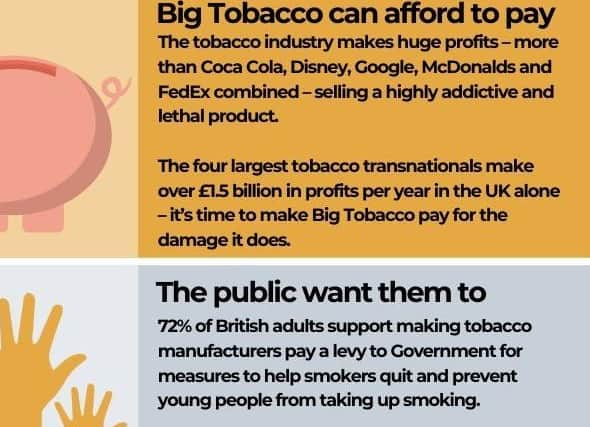No smoking campaigner says ‘give quitting a chance’


This month often brings the dangers of nicotine sharply into focus as National No Smoking Day is on March 11.
But the campaign to stop smoking doesn’t just last a day, it has been going on for many decades and the fight continues apace.
Advertisement
Hide AdAdvertisement
Hide AdPublic health charity ASH (Action on Smoking and Health) has been urging people to quit since 1971. But it doesn’t condemn smokers - it uses evidence and advocacy to help them see the light.


ASH’s director of policy and communications, Ciaran Osborne, believes there are several methods to inspire people to ‘give quitting a chance’.
He said: “There are a bunch of ways that people can help themselves be successful if they try to quit. People can access Nicotine Replacement Therapy either through their GPs, through their local stop smoking service or they can buy them over the counter.”
They can also switch to the electronic vaping method, which cuts out many of the harmful products found in tobacco.
Advertisement
Hide AdAdvertisement
Hide AdMr Osborne added: “People may want to start using an E-cigarette, which Public Health England says is 95 per cent less harmful than smoking. All the evidence to date shows they are significantly less harmful than smoking tobacco. They are a kind of nicotine delivery method, so people who are addicted to nicotine can use them to manage their nicotine cravings.”


E-cigarettes are now the most popular quitting aid in England, according to a health study.
The Government is also committed to driving smoking numbers down. Last year it set a deadline to go ‘smoke free’ by 2030. In essence, it wants to create a generation where less than five per cent of people will smoke.
ASH was heavily involved in submissions to ‘The Advancing our health: prevention in the 2020s’ consultation paper. The Government is expected to publish its conclusions this Spring, and Mr Osborne believes it should do so as soon as possible.
Advertisement
Hide AdAdvertisement
Hide AdHe said: “Every day the Government delays the less likely we are to hit the 2030 target. Every day in England 280 children start smoking and about 200 people die from smoking.
“The 2030 target is ambitious but it is achievable if we do a series of additional measures to help us get there. But we need to start acting on those measures as soon as possible.”
He wants to see the Government recommit to the 2030 deadline and to introduce a ‘polluter pays levy’. This concept would see the big tobacco companies foot the bill for initiatives like no smoking campaigns and enforcement measures against underage tobacco sales. ASH estimates the levy could raise at least £265m annually. They say it could also help pay for stop smoking services, which are under pressure financially. An ASH survey earlier this year revealed nearly a third of local authorities no longer provide a specialist stop smoking service because of budget cuts.
But he wants to make sure that all sections of society benefit from the 2030 pledge.
Advertisement
Hide AdAdvertisement
Hide AdHe said: “Overall smoking prevalence is going down reasonably quickly, and it will be close to five percent by 2030 if it sticks at the current rate of decline. But there are groups of people, particularly those with mental health conditions, those in routine and manual occupations and people living in social housing, which have substantially higher rates of smoking currently. Additional work will be needed there to make sure those groups get the support that they need to quit. So we want to see some of the additional investment targeting people in those groups to make sure health inequalities don’t widen and people aren’t worse off.”
Mr Osborne believes the 2030 target is obtainable if everyone pulls together, but smokers also need to play their part. He added: “The over-arching message from our perspective, is give quitting a chance. The more times you try to quit the more likely you are to succeed.”